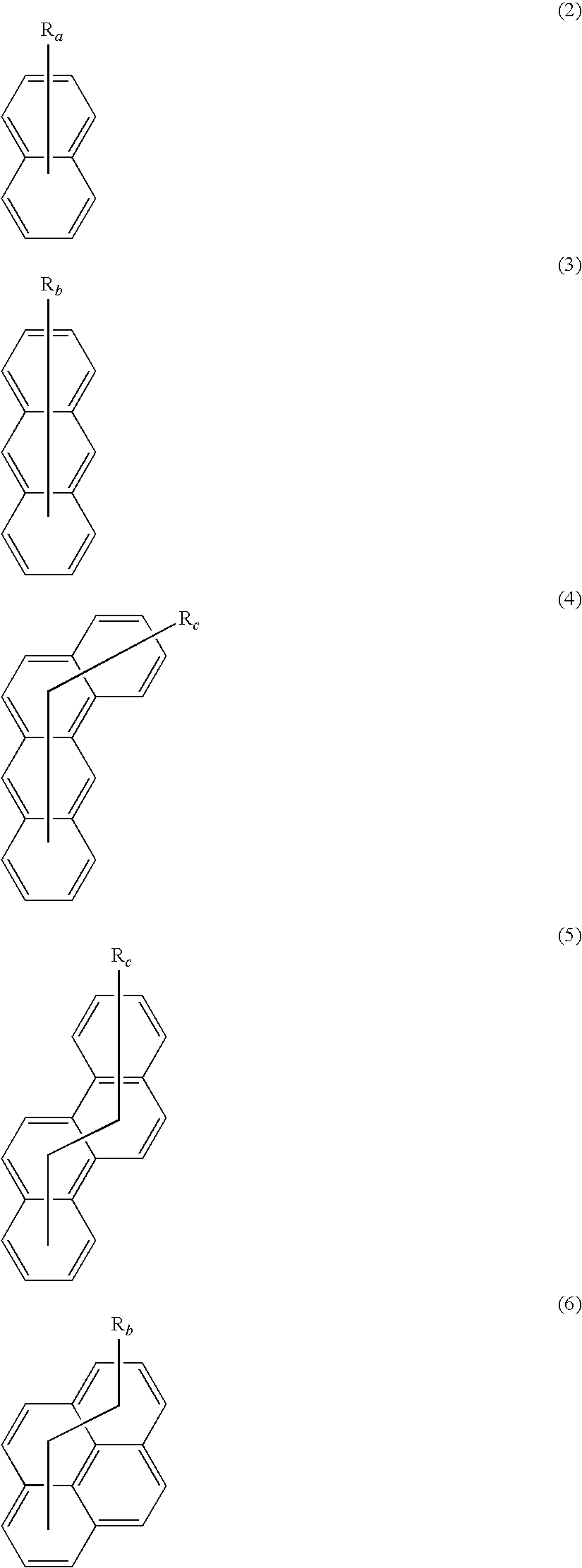Polymeric compound and organic electroluminescence element comprising the same
a technology of organic electroluminescence and polymer compound, which is applied in the direction of pyrene dye, perylene derivative, anthracene dye, etc., can solve the problems that the device characteristics such as lifetime (half lifetime) and emission efficiency of the above-mentioned polymer are not necessarily sufficient, and achieve excellent device characteristics such as lifetime and emission efficiency
- Summary
- Abstract
- Description
- Claims
- Application Information
AI Technical Summary
Benefits of technology
Problems solved by technology
Method used
Image
Examples
example 1
(1) Synthesis of Monomer
[0111]
[0112]Into a 300-ml three-necked flask equipped with a cooling column, 3.8 g (10 mmol) of 6,12-dibromochrysene, 5.83 g (25 mmol) of tolylnaphthylamine, 0.03 g (1.5 mol %) of palladium acetate, 0.06 g (3 mol %) of tri-t-butylphosphine, 2.4 g (25 mmol) of sodium t-butoxide, and 100 ml of dry toluene were charged in an argon atmosphere. The mixture was heat-dried over one night at 100° C. After the reaction, the precipitated crystals were collected by filtration and washed with 50 ml of toluene and then 100 ml of methanol, to obtain 5.9 g of pale yellow powder (Intermediate a, 85% yield).
[0113]Into a three-necked flask, 5.9 g (8.54 mmol) of Intermediate a and 150 ml of N,N′-dimethylformamide were charged in argon atmosphere. Then, a solution of 3.11 g (17.5 mmol) of N-bromosuccinimide in 10 ml of dry N,N′-dimethylformamide was added to the flask dropwise at 25 to 35° C. After the dropwise addition, the reaction liquid was refluxed under heating for 2 h to ...
example 2
(1) Synthesis of Monomer
[0119]In the same manner as in Example 1, Monomer 1 shown in Table 1 was synthesized.
(2) Synthesis of Polymer
[0120]Into a 300-ml three-necked flask equipped with a cooling column, 0.180 g (0.24 mmol) of Monomer 1, 0.938 g (3.28 mmol) of Monomer 2 (2,6-dibromonaphthalene), 0.113 g (0.48 mmol) of Monomer 3 (1,3-dibromobenzene), 1.66 g (3.96 mmol) of Monomer 4, 2.7 mg of palladium acetate, 29.6 mg of tris(2-methoxyphenyl)phosphine, Aliquat 336 (0.52 g, manufactured by Aldrich Chemical Co., Inc.), and 40 ml of dry toluene were charged. The mixture was heated to 105° C. The resulting reaction liquid was added dropwise with a 2 M Na2CO3 aqueous solution (10.9 ml) and refluxed for 8 h. After the reaction, 50 mg of phenyl borate was added and the reflux was further continued for 2 h to allow the reaction to proceed. After adding an aqueous solution of sodium diethyldithiacarbamate, the mixture was stirred at 80° C. for 2 h. After cooling, the mixture was extracted wi...
PUM
| Property | Measurement | Unit |
|---|---|---|
| Structure | aaaaa | aaaaa |
| Efficiency | aaaaa | aaaaa |
| Molar ratio | aaaaa | aaaaa |
Abstract
Description
Claims
Application Information
 Login to View More
Login to View More - R&D
- Intellectual Property
- Life Sciences
- Materials
- Tech Scout
- Unparalleled Data Quality
- Higher Quality Content
- 60% Fewer Hallucinations
Browse by: Latest US Patents, China's latest patents, Technical Efficacy Thesaurus, Application Domain, Technology Topic, Popular Technical Reports.
© 2025 PatSnap. All rights reserved.Legal|Privacy policy|Modern Slavery Act Transparency Statement|Sitemap|About US| Contact US: help@patsnap.com



